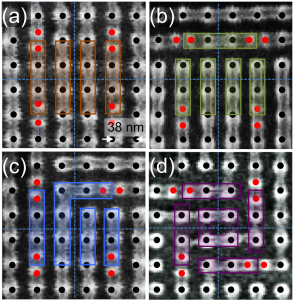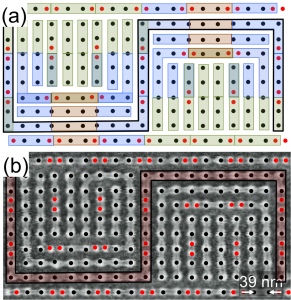Rule-based Directed Self-assembly of Circuit-like Block copolymer Patterns
- Category: Nanotechnology
- Tags: jae-byum chang, karl berggren
Templated self-assembly of block copolymers using topographic templates is attractive because it can generate dense nanoscale patterns over a large area with a periodicity down to 10 nm. In our previous work, regular patterns were achieved by using a polystyrene-b-polydimethylsiloxane (PS-b-PDMS) block copolymer and topographic templates[1]. However, more complex block-copolymer patterns required similarly complex templates. As a result, a complex circuit‑layout pattern over a large area can only be achieved using a template with many different and non-periodic features.
Here, we describe an approach to this problem that uses a topographic template consisting of a square lattice of posts with a restricted set of post motifs. Since a finite number of post motifs are considered, block-copolymer patterns from all possible square geometry templates with these post motifs can be studied. We used a superlattice structure consisting of a sparse array of double posts distributed among a dense array of single posts. When this template was used to guide a 45.5 kg/mol PS-b-PDMS block copolymer with 32 vol% PDMS, the PDMS cylinders that assembled over double posts were aligned parallel to the double post direction. However, the orientation of the PDMS cylinders assembled over single posts depended on the orientations of the neighboring double posts. Figure 1 shows the PDMS patterns templated by four neighboring double posts. Each double post can be aligned along one of the two directions with 16 (24) combinations of the orientations of the four double posts. These 16 combinations can be grouped into four nonequivalent arrangements, shown in Figure 1. To demonstrate that patterns needed for components of integrated circuits (IC) can be fabricated based on these four arrangements, we fabricated an array of bends, one of the essential components of an IC layout. Figure 2(a) shows a proposed template layout to achieve an array of bends. As shown in Figure 2(b), the array of bends was successfully fabricated in accordance with predictions.
- Figure 1: SEM images of the most frequently observed patterns formed on the four arrangements (gray scale). Sketched black dots: single posts; red dots: double posts. Blue dotted lines were drawn to clearly show that one out of every nine single posts was replaced with a double post. Colored rectangles: predicted PDMS patterns of each arrangement. Different colors distinguish the predicted patterns of different arrangements.
- Figure 2: Controlled complex target pattern fabrication. (a) Template layout to fabricate an array of bends. Each color represents the pattern templated by each arrangement. (b) SEM image of the PDMS patterns formed by the template in (a).
- J. K. W. Yang, Y. S. Jung, J. Chang, R. A. Mickiewicz, A. Alexander-Katz, C. A. Ross, and K. K. Berggren, “Complex self-assembled patterns using sparse commensurate templates with locally varying motifs,” Nat. Nanotechnol., vol. 5, pp. 256-260, Mar. 2010. [↩]

